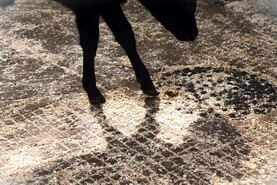The 2022 finishing cattle performance reported in recent weeks has sparked many queries and questions from readers which is what the programme is all about – sparking debate and trying to fill some of the knowledge gap that lies within the ever-changing dairy beef sector.
One constant query we receive is why the programme does not have any Friesian bull calves on the demonstration farm.
From its inception, a key focus of the Thrive programme has been on improving the quality of the beef bull being put on dairy cows to help improve the beef characteristics of the resultant calf.
After a period of rapid expansion within the dairy herd, there was always going to come a time when dairy cow numbers plateaued and therefore the need for replacement dairy stock would be reduced. When this happened, more beef semen has and is now being used on dairy cows.
Beef AI straws
This, along with the increased usage of sexed semen in 2022, resulted in double-digit percentage increases in the amount of beef AI straws used on dairy cows.
Figures from the ICBF forecast that the number of beef-sired calves coming from the dairy herd will rise from around 600,000 to 900,000 in the next five years. At the same time, male dairy-dairy calves will remain constant at around 700,000 head.
With such an increase in beef-sired dairy stock coming on stream, there is a huge opportunity to improve the overall quality of that animal in the coming years. By working on the beef sire offering now, it gives the industry time to adopt new technologies such as the beef sub-index within the dairy beef index (DBI) and the commercial beef value (CBV).
If the Thrive programme was to take in Friesian bull calves, no matter what the outcome it would have little or no impact on the future breeding programme for dairy bulls as they are primarily bred for dairy traits.
However, highlighting the benefits of using better beef bulls on dairy herds can help achieve huge gains in the quality of the beef calf coming from the dairy herd.
Also, there are already a number of programmes looking at Friesian bull calf systems and so it was felt that another one would not add to the knowledge already there.
Work from Teagasc Grange has shown that Friesian bull calves can compete financially with their beef-sired counterparts but much of this comes back to the calf price differential between the dairy male calf and the beef-sired calf.
Too often, the additional cost of the beef-sired dairy calf over a dairy male is greater than the genetic potential advantage of the beef-sired animal. This point remains a key challenge for the industry in the years to come.
Read more
Thrive: increased beef price masks production cost hike
Watch: Thrive bullocks average 310kg carcase at 20 months
Dairy-beef margins up 57% in 2022
The 2022 finishing cattle performance reported in recent weeks has sparked many queries and questions from readers which is what the programme is all about – sparking debate and trying to fill some of the knowledge gap that lies within the ever-changing dairy beef sector.
One constant query we receive is why the programme does not have any Friesian bull calves on the demonstration farm.
From its inception, a key focus of the Thrive programme has been on improving the quality of the beef bull being put on dairy cows to help improve the beef characteristics of the resultant calf.
After a period of rapid expansion within the dairy herd, there was always going to come a time when dairy cow numbers plateaued and therefore the need for replacement dairy stock would be reduced. When this happened, more beef semen has and is now being used on dairy cows.
Beef AI straws
This, along with the increased usage of sexed semen in 2022, resulted in double-digit percentage increases in the amount of beef AI straws used on dairy cows.
Figures from the ICBF forecast that the number of beef-sired calves coming from the dairy herd will rise from around 600,000 to 900,000 in the next five years. At the same time, male dairy-dairy calves will remain constant at around 700,000 head.
With such an increase in beef-sired dairy stock coming on stream, there is a huge opportunity to improve the overall quality of that animal in the coming years. By working on the beef sire offering now, it gives the industry time to adopt new technologies such as the beef sub-index within the dairy beef index (DBI) and the commercial beef value (CBV).
If the Thrive programme was to take in Friesian bull calves, no matter what the outcome it would have little or no impact on the future breeding programme for dairy bulls as they are primarily bred for dairy traits.
However, highlighting the benefits of using better beef bulls on dairy herds can help achieve huge gains in the quality of the beef calf coming from the dairy herd.
Also, there are already a number of programmes looking at Friesian bull calf systems and so it was felt that another one would not add to the knowledge already there.
Work from Teagasc Grange has shown that Friesian bull calves can compete financially with their beef-sired counterparts but much of this comes back to the calf price differential between the dairy male calf and the beef-sired calf.
Too often, the additional cost of the beef-sired dairy calf over a dairy male is greater than the genetic potential advantage of the beef-sired animal. This point remains a key challenge for the industry in the years to come.
Read more
Thrive: increased beef price masks production cost hike
Watch: Thrive bullocks average 310kg carcase at 20 months
Dairy-beef margins up 57% in 2022






 This is a subscriber-only article
This is a subscriber-only article











SHARING OPTIONS: